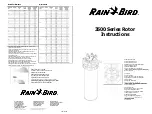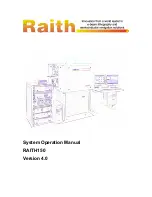
The “M” command allows the user to examine/modify one
memory location at a time. The parameter provided is the first
address for examination. The monitor will show the contents of
the memory location and wait for the user to type a character. If
the character typed is a hexadecimal value, the monitor will
accumulate digits until the RETURN key is pressed, at which
time the last two hex digits will be used to modify the memory
and the next higher location will be displayed. If the user types
a “P” character, the current location remains unaltered, and the
next lower (or previous) location will be displayed. If the “N”
key is pressed, the current location is left unchanged and the
next higher location is displayed. To exit back to the monitor
prompt, press the CONTROL-X character. Some examples of
the “M” command follow:
ON-LINE: M D000 Modify memory starting at D000 hex.
D000 02 N
Show the next two
D001 2B N
locations of memory.
D002 06 P
Show the previous
D001 2B P
seven locations
D000 02 P
of memory.
CFFF 00 P
CFFE 80 P
CFFD 00 P
CFFC 80 P
CFFB 00 FF
Change this location to FF hex.
CFFC 80 ^X
Exit back to the monitor prompt.
ON-LINE:
The “D” command is used to read the USER PROGRAM
AREA out of the micro controller, format it into a special form
called INTEL ASCII HEX format, and list it out the serial port.
If a terminal is attached to the serial port, the formatted data
area will be shown on the screen. If a remote computer is
attached to the serial port, it can read the uploaded data area
and save it away. This type of data transfer is desirable because
it incorporates a high level of error checking. The “L” com-
mand provides the inverse function for this transfer link. It
receives an incoming INTEL ASCII HEX file and loads it into
the USER PROGRAM AREA within the model 8018 micro
controller. The formatted data file would appear as follows if
the “D” command were used with a CRT terminal.
ON-LINE: D
:10000000022B0600000000060000000006000000B1
:1000100000060000000006000000000600000000CE
:1000200006000000000600000000060000000006B8
:1000300600000000060000000006000000000600AE
:10004000000000060000000006000000000600009E
:10005000000006000000000600000000060000008E
:10006000000600000000060000000006000000007E
:100070000600000000060000000006000000000668
:10008006000000000600000000060000000006005E
:10009000000000060000000006000000000600004E
:1000A000000006000000000600000000060000003E
:1000B000000600000000060000000006000000002E
:1000C0000600000000060000000006000000000618
:1000D006000000000600000000060000000006000E
:1000E00000000006000000000600000000060000FE
:1000F00000000600000000060000000006000000EE
:1001000000060000000006000000000600000000DD
:1001100006000000000600000000060000000006C7
:1001200600000000060000000006000000000600BD
:1001300000000006000000000600000000060000AD
:10014000000006000000000600000000060000009D
:10015000000600000000060000000006000000008D
:100160000600000000060000000006000000000677
:10017006000000000600000000060000000006006D
:10018000000000060000000006000000000600005D
:100190000000060000000002000100320102030A14
:0000000000
The “X” command is the only means of exiting the monitor
mode short of turning the power off. When it is invoked, the
CLEAR-SCREEN character sequence is issued, and the micro
controller resumes program execution at the program point just
prior to entry into the monitor mode. This allows the user to
enter the monitor mode by pressing the “#” character, alter
some system parameter, and continue execution by entering the
“X” command. The user has complete control of the entire
micro system when in the monitor mode, therefore if the system
memory is altered in such a way that critical information has
been corrupted, unpredictable results will occur when the “X”
command is executed.
Models 1010 and 1011__________________________________________________________________________Operation
4 - 11









































